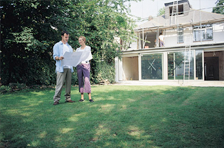|
Remember the audit is just the first step
|
|||
 |
 |
 |
 |
|
Professional Testing & Diagnosis – Conduct a comprehensive Home Energy Audit to assess the energy efficiency of your house. |
Analysis- Carefully analyze the results of the Home Energy Audit / test to identify areas that needs improvement. We furnish a comprehensive report and pinpoint improvements base on priority. |
Remediate – Implement green home improvements based on the comprehensive analysis. | Validate- Test all green home improvements to ensure that we met our energy efficiency goals. |
| < Go Back To Diagnosis and Analysis Page | Go To Energy Efficiency & Performance Main Page > | |||
![]()
Home Energy/ Performance Retrofit & Remodeling
Greenhouse offers a wide range of energy efficient retrofits and construction services. We are devoted to make your house healthy and more energy efficient. Having personnel that are building performance and renewable energy specialists you can feel confident that we will get the project done right.

|
Healthy Home Inspection & Remediation - A holistic inspection, testing and remediation services (combining building science and (NCHH) National Center for Healthy Housing guidelines) to reduce allergens, moisture, pest, indoor pollutants, prevent illness and reduce injury from accidents at home. |
 |
Light Efficiency retrofits - Reduce energy consumption through the use of energy efficient lighting |
 |
Duct Cleaning - Clean out dirty duct system to remove air contaminants and improve the air conditioning system efficiency |
 |
Duct Sealing - Seal leaky ducts that is the primary cause of severe Indoor Air Quality problems, and increase energy use |
 |
Building Envelop Sealing and Weatherization- Seal leaks in building envelop penetrations, seams and in unconditioned spaces |
 |
Day Lighting- Installation of skylights and solar light tubes to reduce lighting load |
 |
Glazing - Replace older low efficiency windows with Low-E efficient widows/ glazing |
 |
Water heater replacement - Tankless water heaters used 40% less energy, have 30+ year lives and give endless hot water. |
 |
AC Improvements- depending on your house and your family’s needs – we’ll work with you to right size your AC unit and upgrade your condensing units to high efficiency SEER 14 or greater units. |
 |
Insulation - Blow-in insulation brings an effective R-20 to the attic, much greater then older-home insulation. |
 |
Hot Water Pipe Insulation- Insulate hot water pipe and heater to improve efficiency. |
 |
Crawl Space Sealing- Seal crawlspace to prevent moisture and air infiltration. |

 Sign-up for a free alternative energy consultation
Sign-up for a free alternative energy consultation
Carbon Output Widget
|
|
||








